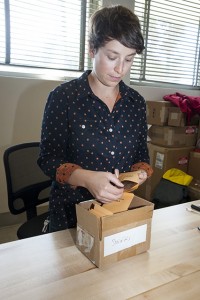CSUN Geology Professor Studies Environmental Change in Grasslands

CSUN geology professor Jennifer Cotton depicts the different areas in North America affected by vegetation change. Photo by Ruth Saravia.
What do old bison hair, teeth and bones have to do with judging the future of Earth’s climate change? They may be the key to understanding how the North American climate has changed in the last 20,000 years, according to California State University, Northridge geology professor Jennifer Cotton.
Since bison eat only grasses, Cotton was able to see what they ate in various periods of time and space by testing the carbon isotopes in the more than 600 samples of bison hair, teeth and bone she acquired. Her study, which was published in the April edition of Science Advances, is the first to create a comprehensive understanding of the spread of various grasses in the North American grasslands, which leads to a better grasp of why certain grasses spread and others did not.
“There are two types of photosynthesis,” Cotton said. “The one you learned in biology, which is used by pretty much everything you see outside today, is what C3 grasses use. The second type is C4, which is used primarily by tropical grasses, corn and sugar cane.
“Between three and eight million years ago, some event took place that caused C4 plants to spread rapidly and take over about 20 percent of terrestrial productivity in a really short amount of time,” she continued. “One of the ideas of the study was to understand what caused that change and try to see if we can use this information to interpret what might happen [to Earth’s vegetation] in the future.”

CSUN geology professor Jennifer Cotton holds a sample of bison hair that was used in her research of grassland changes in North America. More than 600 samples of bison hair, teeth and bone dating back to 20,000 years ago were used in her study. Photo by Ruth Saravia.
“My work showed that precipitation — and specifically the timing of precipitation — is important,” she said. “C4 grasses really like wet conditions during hot times. This has a number of implications. We can now look back in the geologic record and look for more evidence [of] summer precipitation, and see if there are increases in C4 grasses.”
Because C4 grasses are a main staple of the human diet, looking at their spread and what may happen to their spread in the future is important, Cotton said.
“If you think about the future, we are increasing both atmospheric carbon dioxide and temperatures,” she said. “It is not clear what plants are going to do. [C3] likes high levels of carbon dioxide and [C4] likes low carbon dioxide. [C3] likes low temperatures, [C4] likes high temperatures. It is important to humans and food security [and to] economies around the world. They are important to biodiversity. Understanding how they changed in the past can help us with future conservation efforts.”

 experience
experience